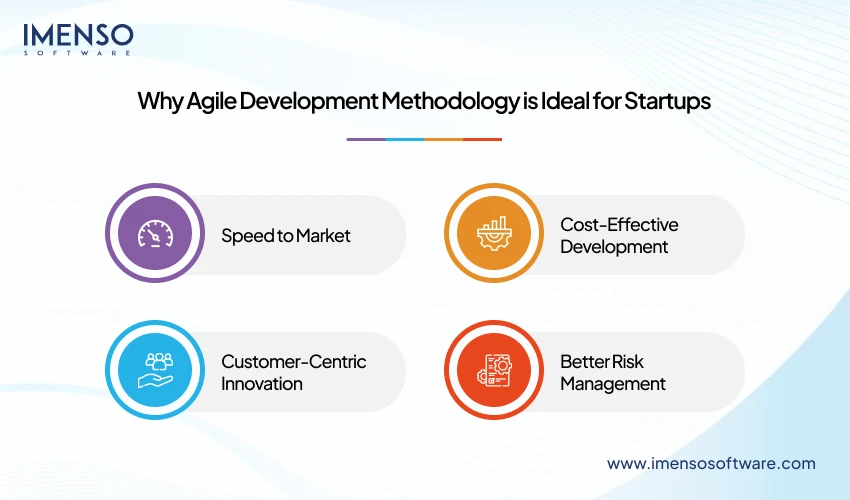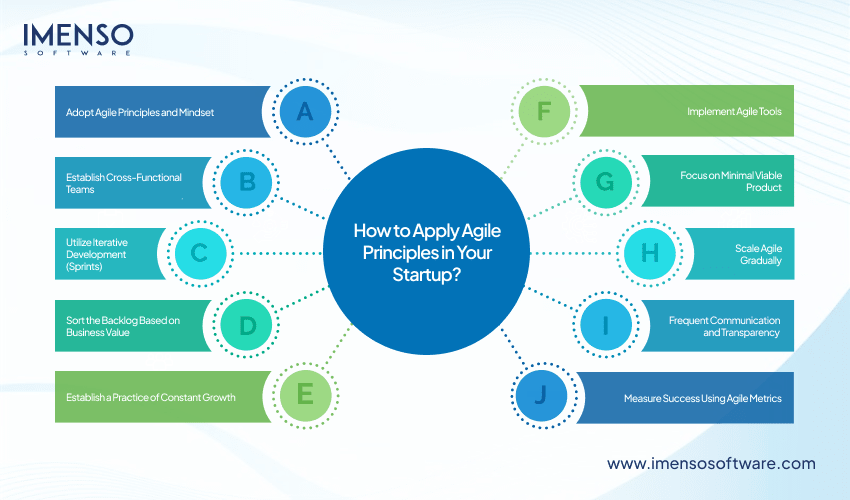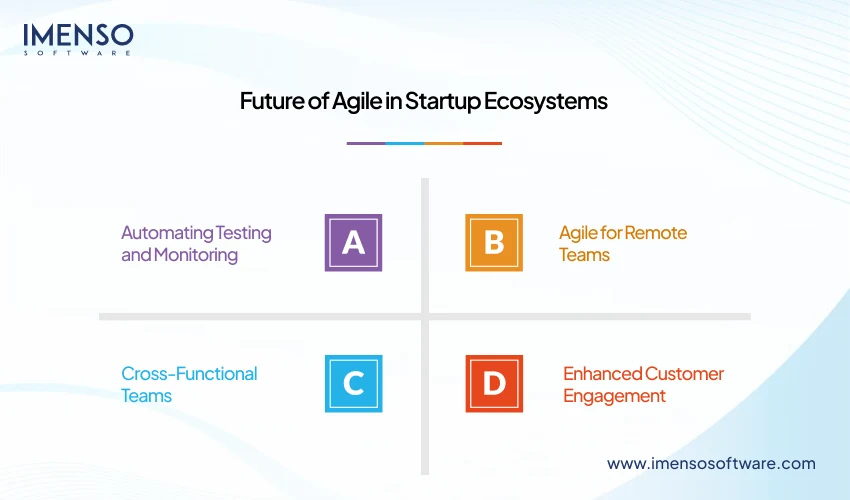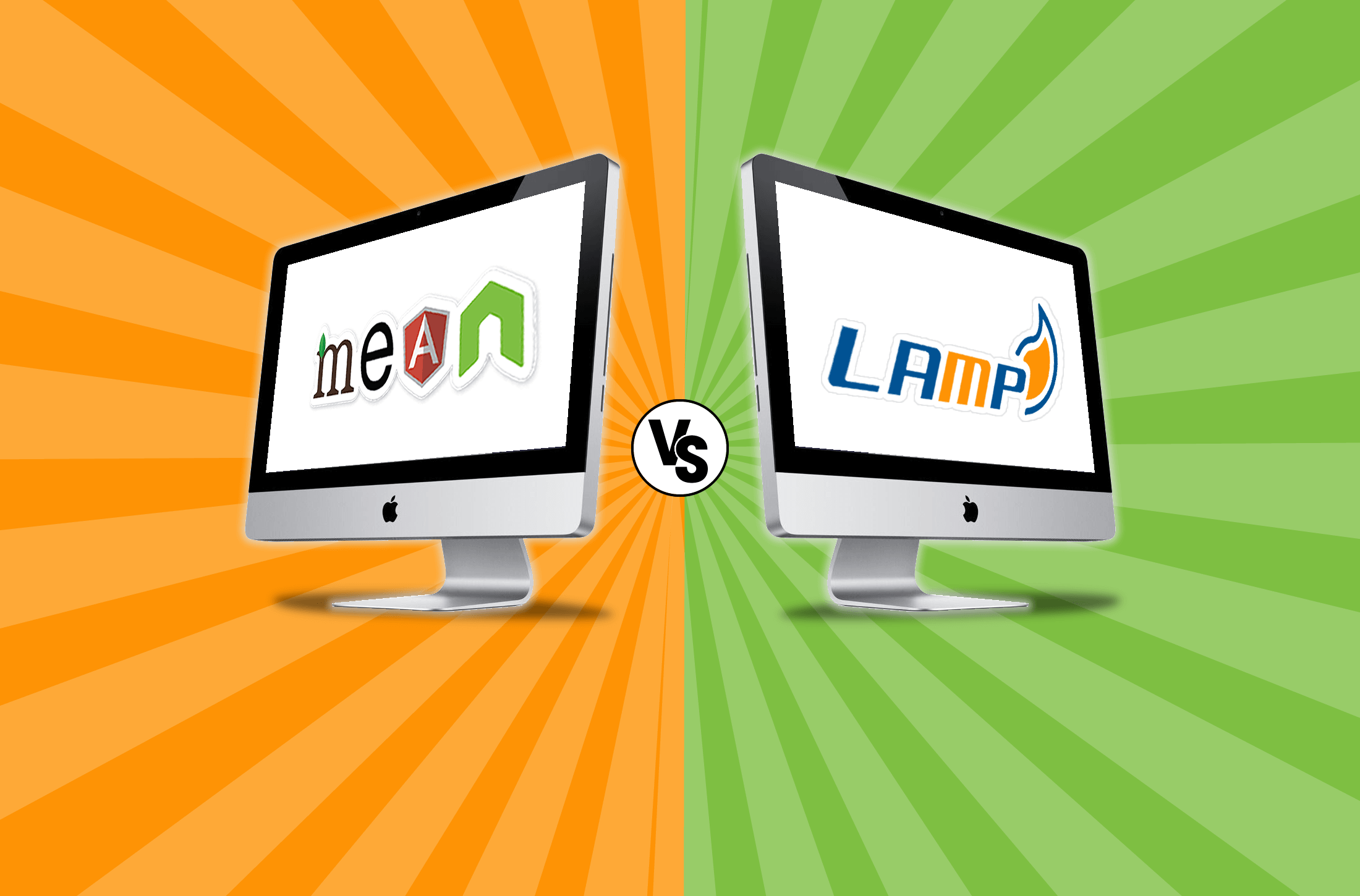How Agile Software Development Can Empower Startups to Innovate Faster

Is your startup struggling to stay ahead of the competition? The revolutions in modern progress and business pace require speed, change, and new ideas. Providing the best products within the shortest time and tightest financing may seem intimidating for new businesses. This is exactly how agile software development changes the narrative.
What if you were able to quickly launch products, achieve a minimal cost of development, and be ready for anything? Agile software development assists startups in having high unrestrained iterations, feedback adjustments, and extraordinary solutions. It is not a surprise that startups all over the globe are adopting Agile approaches.
In this blog, we discuss the key aspects of Agile software development, its significance for early-stage companies, and how it would help achieve faster innovations. We will give particular attention to useful agile practices, upcoming shifts, and practical steps for implementation.
What precisely is Agile Software Development?
Agile Software development revolves around agility, effective teamwork, and customer satisfaction. Normal processes would first create a detailed project plan, while agile development starts with designing a project as smaller parts and calling them ‘sprints’. Each sprint develops one functional version of the software that can then be evaluated and improved.
It requires constant engagement with the stakeholders and quick readjustments. The central beliefs of Agile include:
Individuals and interactions over processes and tools.
Working software over comprehensive documentation.
Customer collaboration over contract negotiation.
Responding to change over following a plan.
Agile is not just an empty phrase. It is a widely recognized method of completing projects in less time, increasing the level of quality and increasing the satisfaction of clients. For the new companies, this is a lifesaver in the ocean of competition.
Why Agile Development Methodology is Ideal for Startups

The adoption of agile development allows startups to continuously change and evolve based on the market’s needs. One of the top software development methodologies, Agile development also emphasizes the importance of time to market, working with the customer, and managing costs and risks, thereby enabling the startup to develop effective competitive and customer-centered products.
Speed to Market
Best software development practices are important for startups facing the pressure to introduce their products into the market. Agile makes it possible to fulfill the development lifecycle in shorter periods, making sure that they release the Minimum Viable Product in a matter of days. This enables the startup to build or improve on their product to suit the customer’s requirements and also expand or maintain their market base.
For instance, a mobile app startup can get particular functionalities built within weeks, allow users to test from the start, and improve based on actual feedback, which makes the product enter the market quicker.
Customer-Centric Innovation
Agile feedback loops bring the customer closer to the center of the process, emphasizing solving real user issues with the final output. This software development for startup strategy lessens the chances of building superfluous features and also increases the likelihood of customer satisfaction.
Involving customers in sprint reviews and planning ensures alignment with their needs, building a loyal user base, and delivering solutions that resonate.
Cost-Effective Development
Agile methodology enables the growth of new ventures while reducing development costs by focusing on core competencies and avoiding non-essential development. This lean method diminishes costs and increases resource utilization effectiveness while maintaining budgets under control.
As an example, features that cannot be efficiently or affordably enhanced are erased in the early development stages due to the assistance of Agile, which enhances the productivity of startup businesses.
Better Risk Management
Conventional practices usually highlight problems very late in the course of action and this brings time and cost overruns. Agile approaches this challenge by slicing projects into smaller, configurable elements, thus allowing assessment and modification of risks as they arise.
Such an approach decreases the risk of having unanticipated events, takes less time and resources, and enables young companies such as startups to remain focused to accomplish the objectives of high product quality.
How to Apply Agile Principles in Your Startup?

Using Agile Software Development to assist startups grow and develop faster means introducing change, interaction, and refinement processes. Here’s how startups can apply Agile methodologies in a better way:
Adopt Agile Principles and Mindset
Agile is ideal for startups due to its emphasis on collaboration, flexibility, and delivery with the customer in mind. With Agility, a startup can provide value over phases and in response to feedback, making it possible to improve the product and remain relevant in the market quickly. This increases effectiveness and minimizes wastage.
- Focus on customer collaboration and feedback.
- Deliver working software frequently for validation.
- Embrace change and prioritize value-driven development.
Establish Cross-Functional Teams
Multi-disciplinary teams bring together different skills thereby enabling issues to be dealt with quickly in time. This has to do with decision-making. There is a reduced silo mentality, increased collaboration and creativity and there is focus on achieving objectives. With teams trusted, accountability is birthed and time to innovate is reduced.
- Promote collaboration between roles.
- Empower teams to make decisions quickly.
- Foster creative problem-solving and reduce silos.
Utilize Iterative Development (Sprints)
Sprints give a startup much advantage because they allow the firm to provide its worth within a short duration, get clients’ reactions, and make changes that matter. Breaking work into manageable chunks allows teams to hit targets as scheduled and allows them to make developments while doing so.
- Use short sprints (1-2 weeks) for faster results.
- Gather feedback after each sprint to refine the product.
- Focus on frequent, incremental improvements.
Sort the Backlog Based on Business Value
Sorting the backlog is essential to ensure maximum focus is placed on the tasks that matter the most. For a startup, it is essential to divide the tasks into groups that work towards the targeted business goals. Regular updates keep priorities relevant and the team focused.
- Prioritize tasks based on business value and impact.
- Align development efforts with strategic goals.
- Regularly update the backlog with stakeholder input.
Establish a Practice of Constant Growth
Agile teaches teams to constantly think, analyze, and improve the processes in place. Retrospectives highlight bottlenecks and opportunities, fostering a culture of experimentation and innovation that helps startups adapt quickly.
- Hold retrospectives to identify improvements.
- Embrace experimentation and learn from failures.
- Continuously refine processes for efficiency.
Implement Agile Tools
Agile Tools such as Jira and Trello create an easy environment as they promote objective tracking at all times as well as push for task prioritization. Automation tools, for instance, CI/CD pipelines, increase the pace of test and deployment phases ensuring that the end results are achieved faster and processes are less complicated.
- Use project management tools to track progress.
- Automate testing and deployment for speed.
- Enhance collaboration through visualized workflows.
Focus on Minimal Viable Product
An MVP is used for businesses and startups to identify the key characteristics they need to get the opinion of their users as fast as possible. One of the ways to use this approach is to save resources, confirm the assumptions given, and bring the product closer to what the consumers want.
- Build a basic MVP with core features.
- Launch early to collect user feedback.
- Focus on refining based on real-world insights.
Also Read: Understanding MVPs: Launch Faster Without Compromising Quality
Frequent Communication and Transparency
Regular communication helps to prevent disagreements and promotes order among the team. The use of daily standups, sprint reviews, and openness builds trust, supports collaboration, and accelerates decision-making.
- Hold daily standups for updates and blockers.
- Foster transparency across teams and stakeholders.
- Maintain open communication for trust and agility.
Scale Agile Gradually
The agile approach should be put into practice by startups in a more simple manner and increase pace only when teams become effective. This kind of gradual scaling does not put stress on teams and helps the methodology change to suit the organization.
- Begin with one team or project.
- Scale gradually to avoid disruption.
- Adapt Agile practices to organizational growth.
Measure Success Using Agile Metrics
Measurable achievements such as velocity or customer satisfaction in Agile metrics are indicators of improvement and performance. These indicators tell us about the productivity of the team, how well the products fit the market, and opportunities for efficiency.
- Use velocity to measure team capacity and output.
- Gather customer feedback to guide development.
- Refine processes with metrics like cycle time.
Startups wishing to adopt Agile methods may consider employing Agile developers. If you decide to hire a dedicated developer or go for offshore software development, working with Imenso Software will help you implement agile methods in your projects.
Also Read: 10 Signs Your Business Needs Custom Software Development
Future of Agile in Startup Ecosystems

Agile goes beyond being simply a framework; it encompasses a culture that shifts with advancements in technology and business requirements. The following are some of the future trends influencing Agile in the startup ecosystem:
Automating Testing and Monitoring
One of the most automated forms of innovation that’s included in various businesses is Artificial Intelligence, and it is truly revolutionizing agile. AI can compute various, underused resources in a business and create predictions for the future.
With the use of AI in Agile, the scope and objectives set for the businesses become more realistic. The use of AI leads to the greatest satisfaction on behalf of the clients with almost no challenges that can steer the business off its planned course.
Agile for Remote Teams
There are various ways of working remotely in Agile for instance using Slack Zoom and Jira, since they enable remote stand-ups, remote sprint planning, and remote retrospectives. These tools help structure and maintain productivity amongst teams across regions.
Startups gain the advantage of Agile through visibility and recurring meetings which assist in keeping remote teams engaged and accountable for their actions.
Cross-Functional Teams
Agile teams of the future will comprise designers, marketers, and sales staff to enable creativity with different inputs. This also makes the end product more holistic and provides a more complete experience for the user.
Startups can dissolve barriers within departments and increase efficiency by incorporating relevant departments into Agile processes.
Enhanced Customer Engagement
The speed of Agile’s feedback loops brings higher customer engagement with the service or product so that the service or product continues to meet real needs. Testing of users strengthens the trust and loyalty of customers since they feel like their voice is considered.
New businesses can rapidly adapt certain features according to the insights and create products that can fit well in the competitive market.
Also Read:
How IT Services Can Help Startups Innovate Faster
The Role of IT Services in Building Resilient Startup Ecosystems
How Startups Can Scale Smartly: Leveraging Technology and Services
Your Next Step
Agile in the development of software is powerful for small businesses that want to become a pacesetter. It is convenient, saves money and most importantly puts the customer at the center of the development. With the help of methods such as iterative development, daily meetings, and reflections, small businesses have a better chance of maintaining their competitiveness after entering the new market.
For those startups seeking to successfully apply the concepts of Agile, Imenso Software offers high-quality development solutions that will meet your requirements. We have expertise in the best software development practices and methodologies, and our committed developers are ready to help you bring out innovation and quality products.
Check out Imenso Software’s glowing reviews on Clutch and explore how their expertise can empower your startup to achieve remarkable success. Get in touch with us today to transform your ideas into reality and remain in the ruling position of the market.
FAQs
How does Agile software development work?
Agile software development works through iterative cycles termed sprints. Agile emphasizes design, development, implementation, and the testing of the product after taking input from various stakeholders during the development process to make sure the scope and requirements of the project are achieved.
Why is Agile better for software development?
Agile techniques focus on delivering functional models. They emphasize constant interaction and stakeholder engagement. This approach ensures quality, enables quick delivery to clients, and allows efficient handling of new requirements or issues.
What tools can startups use for Agile development?
Startups can use tools like Jira, Trello, Asana, and Slack for Agile development. These tools help teams manage workflows effectively. They allow real-time collaboration, track project progress, and keep workflows transparent for everyone.
How does Agile help manage risks in software development?
Fewer risks are apparent in this framework since the teams deconstruct their work into smaller chunks and address the core aspect at a time for solving potential problems. Therefore, there is a likelihood of consistent testing foremost of every component alongside feedback from the investor. This reduces or eliminates a failing chance of the project.
Can Agile work for remote teams?
Absolutely, if backed with other tools like Zoom and Microsoft Teams along with Miro, Agile suits remote teams well. Virtual stand-ups, planning the sprints, and interaction are all part of the tasks hence, eliminating the worry of remote teams being unproductive.
Want more information about our services?
Similar Posts

MEAN Stack vs LAMP Stack
When you require a server-side infrastructure for your web development project, readily the LAMP stack comes to mind. For years it has acquired the status of default infrastructure choice comprising four most popular languages, respectively Linux, Apache, MySQL and PHP....

How to Create your own Instant Messaging App like WhatsApp with 100% Privacy
Messenger apps are a key part of how humanity interacts in the internet age. These apps have been giving web and mobile app development companies a run for their money by instantly delivering messages in real-time maintaining privacy. ...

Why Small & Medium-Sized Businesses Need A Mobile App?
Many small business owners still think that technology as a business tool is for big tech companies and media publications. But mobile has levelled the playing field for everybody. Whether it’s a multi-billion dollar company or a social media influencer from a remote town of Alaska. The customers of all businesses have a mobile device. ...









